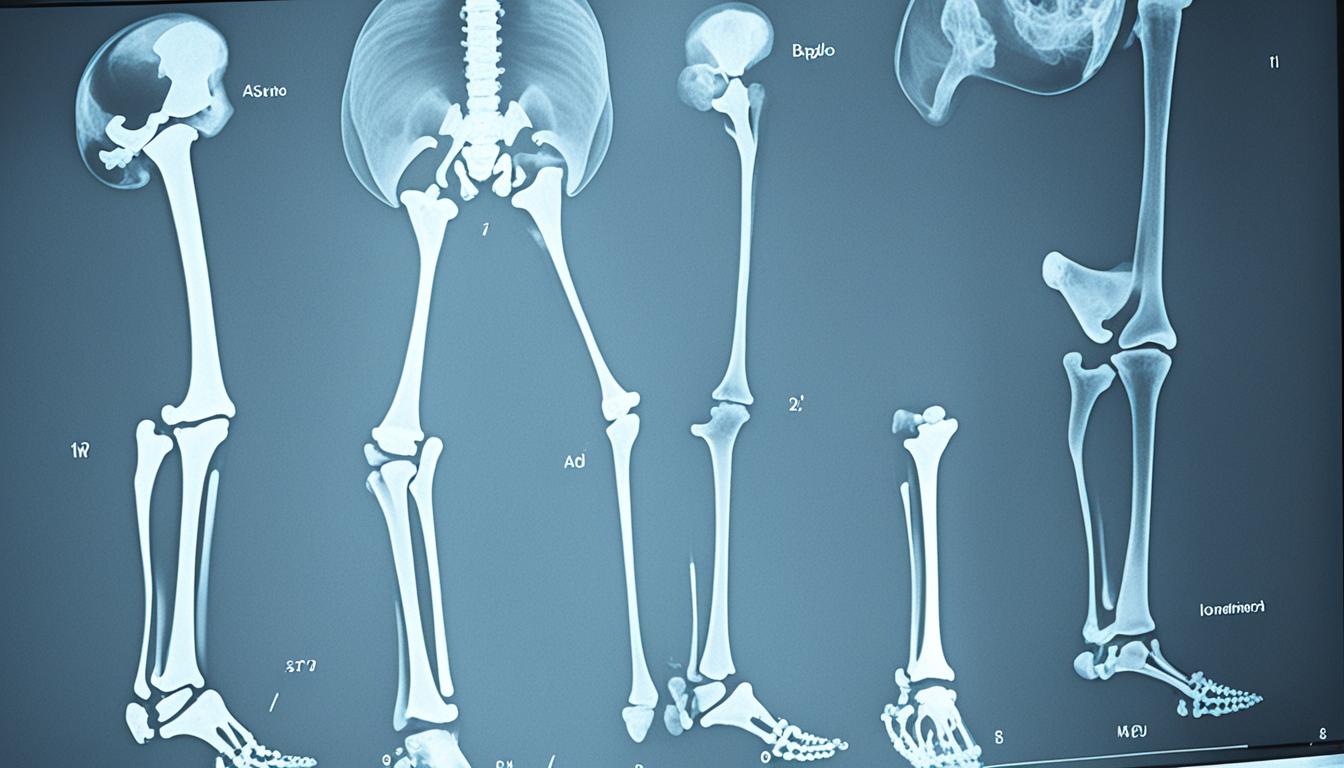Legg-Calve-Perthes, or Perthes disease, is rare. It targets kids aged 4 to 10. The condition appears when there’s a short-term drop in blood supply to the thighbone’s ball-shaped head. This leads to bone loss and damage.
Kids with LCP disease may feel pain in their hip, groin, thigh, or knee. They might limp and have less motion in their hip. Weak muscles are also a common sign. The cause of LCP disease is often unclear. Yet, injuries, infections, genetic issues, or unknown reasons could be linked.
Doctors find LCP through exams and scans like X-rays or MRI. Treatments vary. Some respond well to rest, meds, and physical therapy. For others, surgery to lengthen muscles or reshape the pelvis might be needed.
Now, experts look into using stem cell therapy for LCP. This treatment hopes to use stem cells’ healing power. The goal is to better the recovery chances for those with the disease.
Key Takeaways:
- Legg-Calve-Perthes disease is a rare condition that affects children between the ages of 4 and 10.
- Symptoms of LCP disease include pain in the hip, groin, thigh, or knee, limping, reduced range of motion, and muscle weakness.
- Diagnosis is typically made through a physical examination and imaging tests such as X-rays and MRI scans.
- Treatment options for Legg-Calve-Perthes disease range from nonsurgical approaches to surgical interventions.
- Stem cell therapy is being explored as a potential new treatment option for LCP disease.
Understanding the Phases and Prognosis of Legg-Calve-Perthes Disease
Legg-Calve-Perthes disease (LCPD) moves through four key stages. These are necrosis, fragmentation, reossification, and remodeling. Each part is vital for the hip joint’s recovery in kids with LCPD.
The Necrosis Phase
During the necrosis phase, the femoral head’s blood supply is cut off, causing bone to die. This part shows bone tissues losing strength and collapsing. Kids may feel pain, have less movement, and struggle to use the leg.
The Fragmentation Phase
In the fragmentation phase, the dead bone shatters into small pieces. This process causes more pain and limits movement. The hip joint and femoral head shape might change, making it hard for children to play.
The Reossification Phase
In the reossification phase, new bone starts to grow. It replaces the dead bone, healing the hip’s shape and function. During this, kids may start to feel less pain and move better.
The Remodeling Phase
In the remodeling phase, new bone keeps getting stronger and adjusting to wear and tear. The hip’s function improves. Some experience little to no pain and better movement.
The Prognosis
The outlook for LCPD is usually good, with most kids getting better in 2-3 years or by puberty. Yet, some might have lasting hip joint issues or arthritis. Regular check-ups and proper care help kids do well over time.
| Phase | Description |
|---|---|
| Necrosis | Interruption of blood supply to the femoral head, causing bone death |
| Fragmentation | Breakdown and collapse of the dead bone, leading to pain and limited mobility |
| Reossification | Formation of new bone to replace the dead bone, restoring shape and function |
| Remodeling | Completion of bone healing process, gradual regain of shape and function |
An Overview of Diagnosis and Treatment Options for Legg-Calve-Perthes Disease
To diagnose Legg-Calve–Perthes disease, a doctor will look closely at the child’s symptoms and history. They will also use tests like x-rays to see the hip joint’s shape. MRI scans are used for a closer look at blood flow and soft tissues. Bone scans help spot early bone death signs.
The treatment plan for LCP disease varies based on its severity. For milder cases, treatments include rest, avoiding certain activities, and taking anti-inflammatory drugs. Sometimes, a cast or brace is used along with physical therapy. In more serious situations, surgery might be needed. This can involve procedures like muscle lengthening.
There’s also growing interest in using stem cell therapy for LCP disease. Doctors are studying how stem cells can help heal and make outcomes better. However, more studies are necessary to confirm its benefits in this condition.
FAQ
Q: What is Legg-Calve-Perthes disease?
A: Legg-Calve–Perthes disease is a rare condition affecting kids aged 4 to 10. It happens when the blood flow to the thighbone’s head is cut off. This leads to the bone losing shape and breaking down.
Q: What are the symptoms of Legg-Calve-Perthes disease?
A: People with this disease may feel pain in their hip, groin, thigh, or knee. They might limp or find it hard to move. Muscle weakness is also common.
Q: What causes Legg-Calve-Perthes disease?
A: The exact cause is unknown, but experts think several things might contribute. These include hip injuries, infections, or genetic issues. Some cases are called ‘idiopathic,’ meaning they have an unknown cause.
Q: How is Legg-Calve-Perthes disease diagnosed?
A: Doctors diagnose Legg-Calve-Perthes with physical exams and medical images. X-rays and MRIs show bone problems. Bone scans help find early signs of bone death.
Q: What are the treatment options for Legg-Calve-Perthes disease?
A: Treatments vary. For some, it might be rest, medicine, and exercises. Others might need surgery, like lengthening muscles or changing the pelvis. Stem cell therapy is also being looked into.
Q: What are the phases of Legg-Calve-Perthes disease?
A: There are four main phases: necrosis, fragmentation, reossification, and remodeling. These phases are about the blood supply stopping, the bone breaking, new bone forming, and then the bone healing completely.
Q: What is the prognosis for Legg-Calve-Perthes disease?
A: Many children get better in 2 to 3 years or by puberty. But some may have hip problems or arthritis later on. Overall, the outlook is positive.
Q: How is Legg-Calve-Perthes disease treated?
A: Treatment depends on how bad it is. Mild cases might get better with rest and medicine. Severe cases might need surgery. Stem cell therapy aims to improve healing and outcomes.

